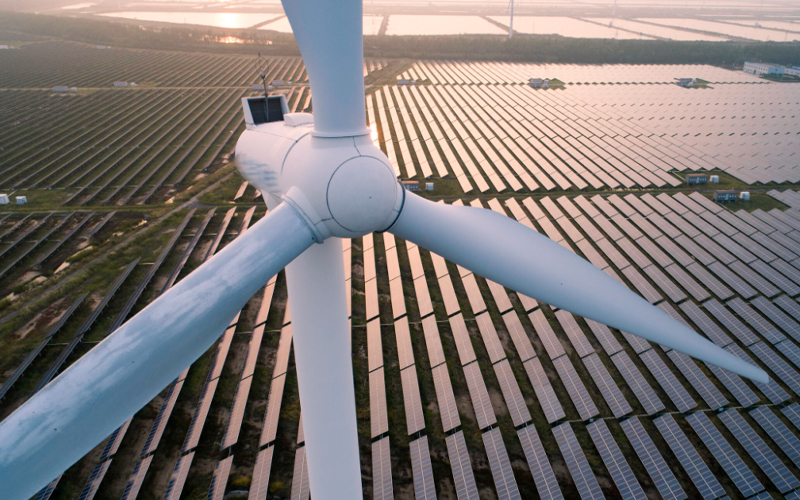The world is becoming increasingly aware of the risks of climate change and actively working towards reducing carbon footprints and achieving carbon neutrality. One of the major focus areas in these efforts is eliminating fossil fuels and other non-renewable resources from the energy and utilities industry. This means relying more on renewable energy resources and making the existing energy grids greener.
Emerging trends in the global renewable energy integration market
The focus on going green, along with the increasing pressure from investors to adopt environmental social governance (ESG) policies, has resulted in a massive shift towards integrating renewable energy resources in modern energy grids. As a result, experts estimate approximately 33% of the world’s electricity will come from renewable sources by 2024, with solar photovoltaic energy leading the growth. Energy and utility industries across the globe are embracing renewable energy resources and innovation to make the industry greener and more sustainable.
The top emerging trends in the global renewable energy market – based on the global practice leaders – include:
- Continual growth of solar and wind capacity across the globe
- Focus on energy storage solutions to increase the reliability and resilience of the decentralised power systems
- Increasing investment in clean technology and renewable energy from established natural resources companies
- Increasing private equity and venture capital investment in cleantech
SDG7: Affordable and clean energy
However, despite the increasing focus and investment in green energy, the potential lack of infrastructure for the sustainable use of renewable resources means that we are not on track to achieve SDG7 targets. UN’s 7th sustainable development goal (SDG7) addresses making affordable, reliable, sustainable, and modern energy accessible to all. It guides global policies and initiatives towards energy accessibility, efficiency, and integration of renewable energy in global energy infrastructure with international cooperation.
However, a joint report from International Energy Agency (IEA), International Renewable Energy Agency (IRENA), the United Nations Statistics Division (UNSD), the World Bank, and the World Health Organisation (WHO) indicates that we are not on track to achieve the SDG7 targets. Looking at data from 2021, 675 million people have limited to no access to electricity, 2.3 million lack access to clean cooking, and despite growing renewable energy deployment, renewable energy resources comprise only 19.1% of the total global energy consumption.
The current state of SDG7 is not conducive to achieving the target of universal and sustainable access to affordable and reliable energy by 2030. The rate of renewable energy deployment and energy efficiency measures must considerably accelerate if we want to realise SDG7. International communities and the energy and utilities industries across the globe need to come together to address the electricity and clean cooking access gaps, partner with utility management services to modernise the global energy infrastructure, and leverage modern technologies to ensure sustainable use of renewable energy sources.
Changing the energy landscape with effective grid integration
With the global focus on renewable energy increasing, the onus is now on the energy and utilities industry to ensure the energy infrastructure and electric grids are ready to shift towards renewable energy resources and clean energy technologies.
Ensuring effective grid integration of renewable energy involves innovation and planning for grid modernisation, reliable, efficient, and cleaner energy generators, and optimising the electricity grids ready for a carbon-free future. This involves giving the grid operators long-term insights into evolving demands and control capabilities to effectively plan and manage the dynamic energy resource mix. It also involves leveraging next-gen technologies and advanced modelling and simulation solutions to optimise the energy market, build resilience against threats (cyberattacks or natural disasters), and build effective risk mitigation protocols for more resilient energy infrastructure.
Utility management services can be a great asset in grid integration of renewable energy – and facilitating a carbon-free future – by providing solutions like:
- Modelling, control, and optimisation tools – with advanced data analytics capabilities – for renewable power grid
- Advanced predictive capabilities to analyse renewable energy resources and systems’ performance
- Advanced predictive tools for risk assessment and mitigation (for example, natural disasters, cyber-attacks, or asynchronous supply)
- Analytics tools for networks – from individual meter to community scale – for better planning and optimisation
- Optimisation solutions for interconnected technologies to improve operational efficiency while reducing costs
Next-gen technology, data analytics capabilities, and AI/ML solutions can help you evaluate data at scale to ensure sustainable use of renewable energy resources while ensuring effective grid integration of green energy alternatives.
For organisations on the digital transformation journey, agility is key in responding to a rapidly changing technology and business landscape. Now more than ever, it is crucial to deliver and exceed organisational expectations with a robust digital mindset backed by innovation. Enabling businesses to sense, learn, respond, and evolve like living organisms will be imperative for business excellence. A comprehensive yet modular suite of services is doing precisely that. Equipping organisations with intuitive decision-making automatically at scale, actionable insights based on real-time solutions, anytime/anywhere experience, and in-depth data visibility across functions leading to hyper-productivity, Live Enterprise is building connected organisations that are innovating collaboratively for the future.
How can Infosys BPM help?
With Infosys BPM energy & utility business process services, you can optimise energy production and scheduling while effectively managing the available renewable energy resources and energy demands. Leverage Infosys BPM’s utility management services to get better access and visibility to available information and ensure faster decision-making to progress towards a carbon-free future.








